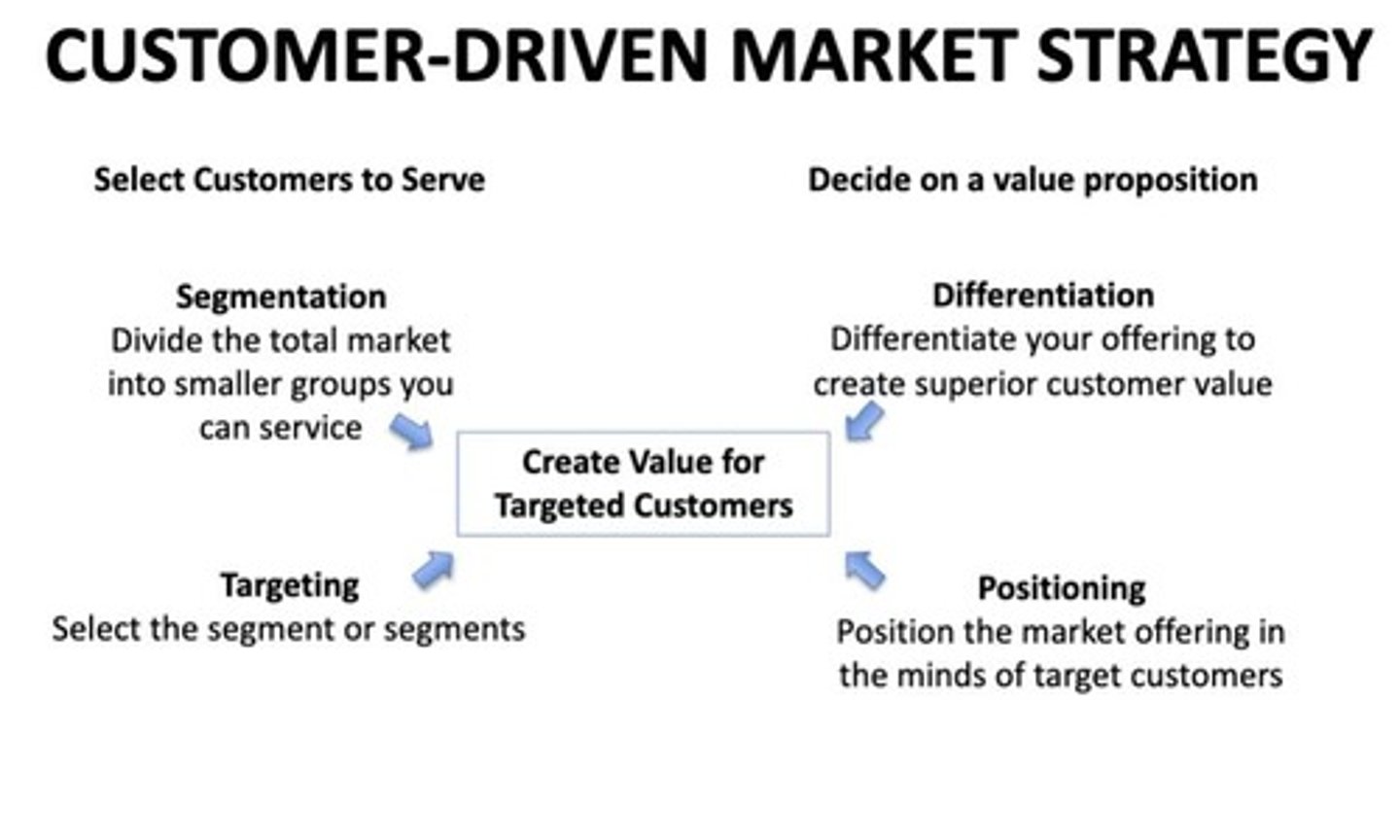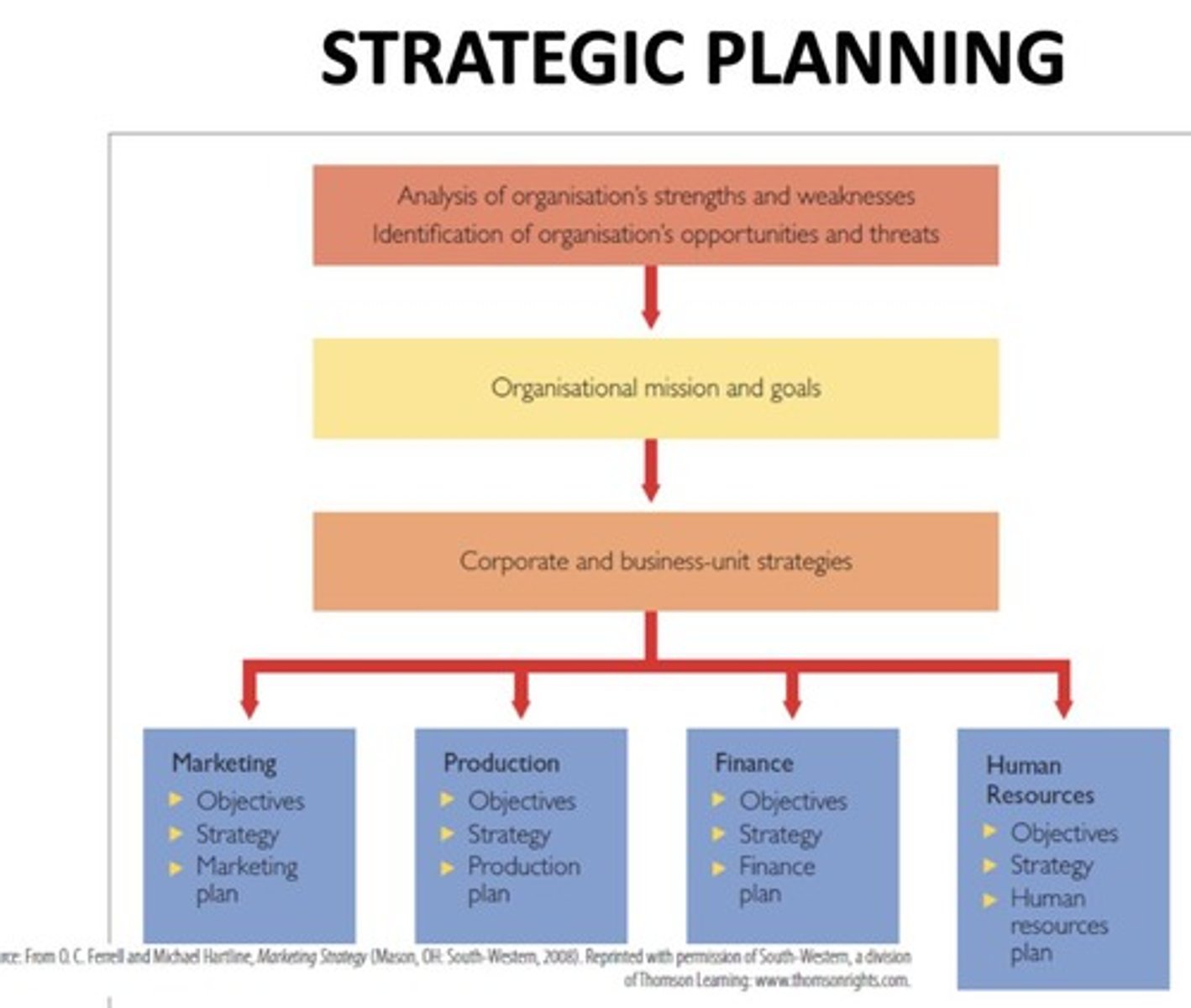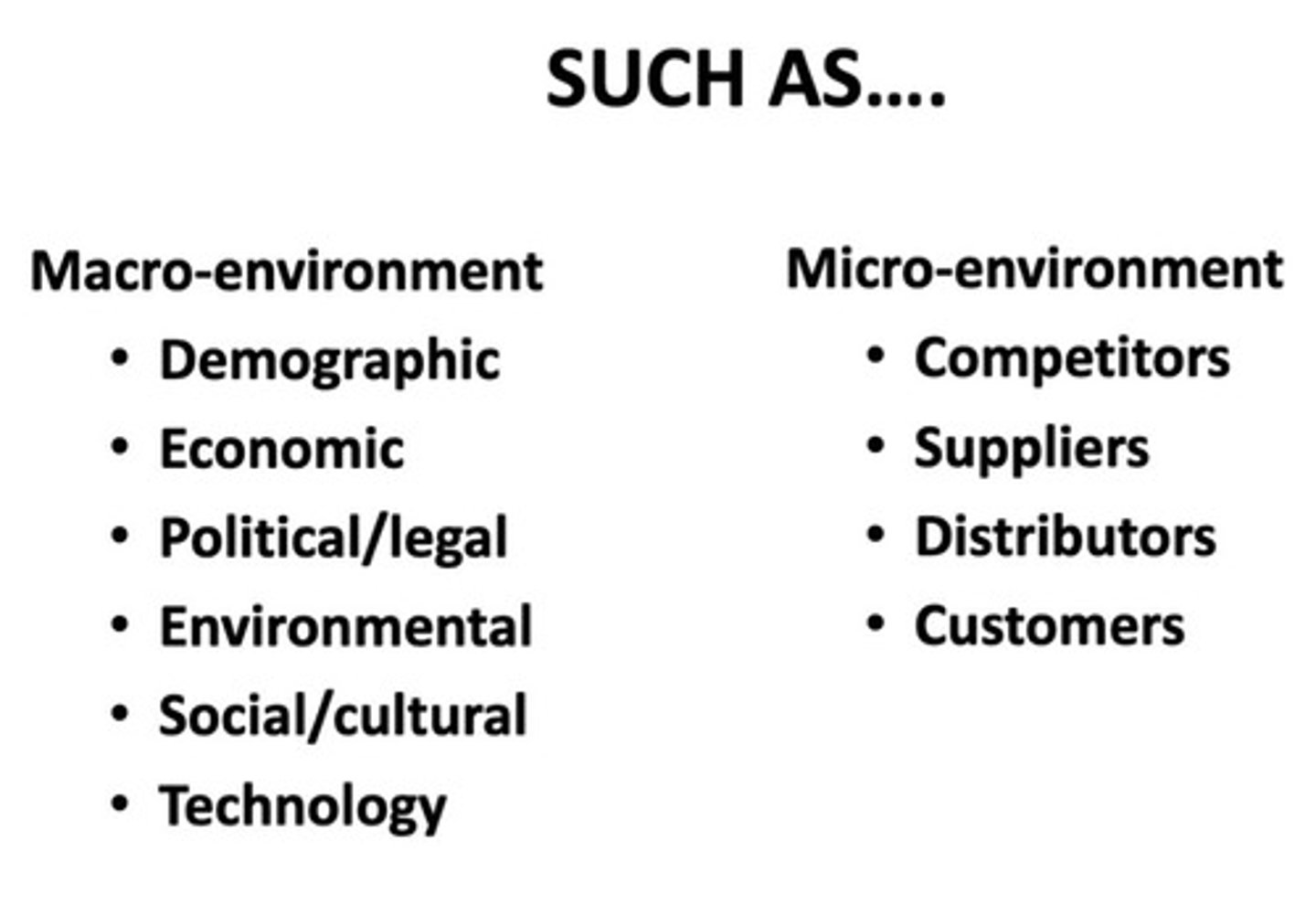Marketing Strategy and Consumer Behavior: Segmentation, Targeting, and Positioning
1/128
There's no tags or description
Looks like no tags are added yet.
Name | Mastery | Learn | Test | Matching | Spaced |
|---|
No study sessions yet.
129 Terms
What are the four main steps in a customer-driven marketing strategy?
1. Market segmentation 2. Market targeting 3. Differentiation 4. Positioning

What is the purpose of market segmentation?
To analyze and divide a market into distinctive groups to direct marketing focus towards segments with different needs, characteristics, or behaviors.
Define 'needs' in the context of marketing.
States of felt deprivation.
How are 'wants' defined in marketing?
Wants are the forms human needs take, shaped by culture and individual personality.
What are 'demands' in marketing terms?
Human wants that are backed by buying power.
What is the TOWS analysis used for?
To measure an organization's relevant strengths and weaknesses against threats and opportunities.

What does positioning involve in marketing?
Arranging for a market offering to occupy a clear, distinctive place in the minds of target consumers relative to competing products.
What is the role of marketing according to the notes?
Marketing is the process by which organizations engage customers, build relationships, and create customer value to capture value in return.
What is the significance of brand loyalty in marketing?
Brand loyalty can influence consumer behavior and purchasing decisions.
What is meant by 'micro-environment' in marketing?
The immediate environment surrounding a company, including customers, competitors, and suppliers.
What is the macro-environment in marketing?
The broader environment that affects the micro-environment, including economic, social, technological, and political factors.

What is a marketing offering?
A combination of goods, services, information, or experiences offered to a market to satisfy a need or want.
What is the purpose of marketing research?
To gather information that is not currently available to decision makers to help resolve specific problems or opportunities.
What are the types of reference groups in marketing?
1. Membership: an individual actually belongs 2. Aspirational: an individual aspires to belong 3. Dissociative: an individual does not want to belong.
What is the importance of customer benefits in marketing?
Customer benefits are the outcomes sought by customers that satisfy a need or want for a price they will pay.
What are the influences on consumer behavior mentioned in the notes?
Peers, leaders, social influences, and cultural factors.
What is the significance of the buyer decision process in marketing?
It helps understand how consumers make purchasing decisions and what factors influence those decisions.
What does 'good strategy' refer to in marketing?
A well-thought-out plan that effectively addresses market needs and leverages organizational strengths.
What methods are used to gather primary data in marketing research?
Observation, interviews, surveys, and experiments.
What is the outcome sought by a customer in marketing?
A solution that satisfies a need or want at a price they are willing to pay.
What is the role of customer needs and wants in marketing?
They inform marketing strategies and offerings to ensure they align with consumer expectations.
What is the significance of understanding threats and opportunities in marketing?
It helps organizations identify potential risks and areas for growth in the market.
What is the goal of marketing?
To obtain what individuals and organizations need and want through creating and exchanging value with others.
What defines a brand?
A brand is a name, term, design, symbol, or any feature that identifies one seller's goods or services as distinct from others.
What is brand identity?
How a marketer wants their brand to be perceived by people.
What is brand image?
How consumers perceive the brand, based on their interpretation.
What are opinion leaders?
Members of a reference group who provide information about specific spheres of interest.
What is qualitative research in marketing?
Research that seeks to understand attitudes and behaviors through non-numeric methods like interviews or observations.
What influences buying behavior according to the notes?
Culture, social surroundings, physical surroundings, and situational influencers.
What are the components of brand identity?
Symbols, logos, colors, slogans, and brand personality.
What are market offerings?
A combination of goods, services, information, or experiences offered to satisfy customer needs or wants.
What is the macro environment in marketing?
The larger external forces that affect marketing management's ability to build relationships with target customers.
What does the microenvironment consist of?
Customers, product market, competitors, company, channels, and logistics.
What is the significance of customer needs in marketing?
Satisfying customer needs is essential for creating value and building customer relations.
What is the purpose of post-purchase evaluation?
To assess whether the purchase satisfies the customer's needs.
What is a sustainable competitive advantage?
A means to achieve an advantage that cannot be easily replicated, lasting for a limited time.
What external factors can affect marketing processes?
Factors that increase costs, reduce control over inputs, or reduce effectiveness of processes.
What is the role of competition in marketing?
Understanding what competitors are doing is crucial for strategic positioning.
What is the importance of understanding demographics in marketing?
Demographics help define the customer and target market.
What are psychographics?
The study of consumer lifestyles, values, and attitudes.
What is the function of marketing intermediaries?
To facilitate the distribution and exchange of goods and services.
What does it mean to co-create value with customers?
Building a relationship with customers to better meet their needs while recognizing the potential for disloyalty.
What are situational influencers in purchasing decisions?
Circumstances surrounding a purchase that can affect decision-making.
What is the significance of strong market orientation?
A focus on customers and competitors that drives profits and commitment to sharing marketing information.
What is the role of opinion leaders in a reference group?
They provide valuable information that influences the decisions of other group members.
What is the definition of a company's marketing environment?
A company's marketing environment consists of actors and forces outside of marketing that affect the marketing management's ability to build and maintain successful relationships with target customers.
What is post-purchase evaluation?
Post-purchase evaluation refers to the assessment made by consumers after buying a product, which can lead to cognitive dissonance or buyer's remorse.
What is cognitive dissonance in marketing?
Cognitive dissonance refers to the doubts a consumer may have about whether their purchase was the right decision.
What are segmentation strategies in marketing?
Segmentation strategies involve identifying market segments, selecting one or more of them, and developing products and marketing programs tailored to each.
What is the definition of a market in marketing terms?
A market is a set of actual and potential buyers of a product.
What does marketing mean?
Marketing means managing markets to bring about profitable customer relationships.
What is the purpose of target marketing strategies?
Target marketing strategies aim to identify specific market segments and tailor products and marketing efforts to meet their needs.
What influences consumer buyer behavior?
Consumer buyer behavior is influenced by cultural, social, personal, and psychological characteristics.
What is the decision process in consumer behavior?
The decision process includes problem recognition, information search, evaluation of alternatives, purchase decision, and post-purchase evaluation.
What is the significance of understanding consumer needs and wants?
Understanding consumer needs and wants allows marketers to influence purchasing decisions in their favor.
What is the role of strategic planning in marketing?
Strategic planning defines the overall purpose and mission of the organization, including goals and marketing strategies.
What is buyer's remorse?
Buyer's remorse, also known as post-purchase dissonance, occurs when a consumer feels regret after making a purchase.
What are opportunities in the context of marketing?
Opportunities are external factors that can reduce costs, improve processes, or increase sales volume and product range.
What is the importance of analyzing the marketing environment?
Analyzing the marketing environment informs long-term decisions and helps identify competitive advantages.
What is the role of social pressure in consumer behavior?
Marketing is socially driven; individuals often behave according to social pressures.
What are the stages in the consumer decision process?
The stages include problem recognition, information search, evaluation of alternatives, purchase decision, and post-purchase evaluation.
What is the impact of demographics on marketing?
Demographics help define customer segments and tailor marketing strategies to meet their specific needs.
What factors shape and drive consumer behavior?
Cultural, social, personal, and psychological factors shape and drive consumer behavior.
How do companies prepare for marketing?
Companies usually prepare annual plans that outline their marketing strategies and objectives.
What is the significance of the customer-driven market strategy?
A customer-driven market strategy focuses on understanding and meeting the needs of the target customers.
What broad influence do cultural factors have on consumer behavior?
Cultural factors exert a broad and deep influence on consumer behavior.
What are the internal factors that impact an organization's ability to achieve its objectives?
Management capabilities, human resources, financial factors, production factors, marketing capabilities, systems and processes, suppliers, and distributors.
What is the most basic cause of a person's wants and behaviors?
Problem recognition.
What is the role of marketers in problem or need recognition?
Marketers may help trigger problem or need recognition.
What does a buyer realize in the process of enabling a transaction?
A buyer realizes the difference between their current condition and a desired state.
What is the purpose of strategic planning in a company?
To find ways in which the company can best use its strengths to take advantage of attractive opportunities in the environment.
What is customer value?
Customer value concerns the difference between the benefits a customer sees from a value proposition and the cost of obtaining those benefits.
What are tangible benefits?
Tangible benefits are quantifiable and easily measured, often having a direct financial impact.
What are intangible benefits?
Intangible benefits are non-monetary and harder to quantify, but still contribute to overall success.
What is the evoked set in consumer decision-making?
The evoked set refers to what is in a consumer's mind and what they are aware of when considering products.
How does perception influence consumer behavior?
How a person acts is influenced by their own perception of the situation, through their five senses.
What are the five core customer and marketplace concepts?
The five core concepts include needs, wants, demand, value, and satisfaction.
What is the buyer decision process?
The buyer decision process involves recognizing needs, searching for information, evaluating alternatives, making a purchase decision, and post-purchase evaluation.
What is the significance of understanding market changes over time?
Understanding market changes helps in positioning and predicting where the market is going.
What is the difference between consumer markets and business markets?
Consumer markets consist of purchasers and household members who intend to consume products, while business markets involve organizations that buy products for profit.
What is customer relationship management (CRM)?
CRM involves working closely with partners in other company departments to form an effective internal value chain that serves the customer.
What is the concept of heuristics in decision-making?
Heuristics are mental shortcuts that save time when making decisions.
What is the sense of deprivation in consumer behavior?
The sense of deprivation refers to the feeling that arises when there is a gap between actual and desired states.
What does it mean to be market-oriented?
Being market-oriented means focusing on customer needs and adapting strategies accordingly.
What is the significance of a mission statement in an organization?
A mission statement defines what the organization wants to accomplish.
What are strategic options in marketing?
Strategic options refer to the various paths a company can take to achieve its marketing goals.
What is the impact of social factors on consumer behavior?
Social factors influence consumer behavior by shaping perceptions, preferences, and decision-making processes.
What are the benefits in marketing?
Benefits are the outcomes sought by a customer that satisfy needs and wants.
What is demand in marketing?
Demand refers to wants backed by buying power.
What are habitual/routine purchases?
Purchases made with little or no conscious effort, often through simple automatic decisions.
What characterizes government markets?
Government markets consist of individuals or groups that purchase specific products for resale, direct use in producing other products, or for general daily operations.
What psychological need can influence purchasing behavior?
The need to be accepted and appreciated.
What is the difference between strategy and tactics in marketing?
Strategy involves planning a route, while tactics are the actions taken to implement that strategy.
What must market segments be in order to be effective?
Segments must be identifiable, recognizable, accessible, and profitable.
What is segmentation in marketing?
Segmentation is the process of dividing the total market into different segments based on customer characteristics.
What factors influence consumer buying behavior?
Demographics, psychographics, behavior, and values.
What is the difference between high involvement and low involvement products?
High involvement products are visible to others and/or expensive, while low involvement products are less expensive with less associated social risk.
What are the four types of market strategies?
Market penetration, market development, product development, and diversification.
What does demographic segmentation include?
Demographic segmentation includes factors such as age, gender, race, income, education, occupation, and family size.
What is geographic segmentation?
Geographic segmentation divides the market based on location factors like climate, terrain, city size, and population density.